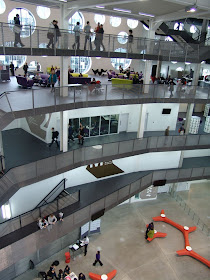London, England
Foreign Office Architects
Post By:Kitticoon Poopong
 |
| Photo © Courtesy of Benedict Luxmoore and Morley von Sternberg |
The new building for Ravensbourne, a university sector college innovating in
digital media and design, is located at
Greenwich Peninsula on the South-Eastern edge of
The O2 building, to the right of the North-South axis that structures the masterplan. By moving to this extraordinary location, Ravensbourne aims to deliver education to meet the shifting demands of 21st century learners – learners who expect access to resources and support on demand and whose needs can differ greatly depending on a variety of social and economic factors.
 |
| Photo © Courtesy of Benedict Luxmoore and Morley von Sternberg |
 |
| Photo © Courtesy of Benedict Luxmoore and Morley von Sternberg |
The new building is designed to stimulate the environment and working practices of creative professionals, providing the best in technology and
mobile computing in an environment which enables a variety of
learning styles.
 |
| Photo © Courtesy of Benedict Luxmoore and Morley von Sternberg |
 |
| Photo © Courtesy of Benedict Luxmoore and Morley von Sternberg |
The main strategy in the design of the building is to produce a structure which will encourage collaboration between the different disciplines and practitioners within Ravensbourne. This will be achieved by structuring the building around a system of two interconnected atria, each piercing through three levels of program.
 |
| Photo © Courtesy of Benedict Luxmoore and Morley von Sternberg |
 |
| Photo © Courtesy of Benedict Luxmoore and Morley von Sternberg |
The atria have been systematically attached to the external facade in order not only to use them as ventilation devices, but also to connect visually the core of the public spaces in the building with the perception of the urban surroundings. The building is specified to reach a BREEAM qualification of environmental excellence.
 |
| Photo © Courtesy of Benedict Luxmoore and Morley von Sternberg |
 |
| Photo © Courtesy of Benedict Luxmoore and Morley von Sternberg |
In order to achieve optimum environmental performance, low maintenance and high flexibility, the massing has been kept as compact as possible with a very low ratio of façade to area, and a deep building which is able to provides flexible space to host the various activities which take place in the building.
 |
| Photo © Courtesy of Benedict Luxmoore and Morley von Sternberg |
The architecture of the building has been designed to express the culture of contemporary production, by using a non-periodic tiling system which symbolises a more diverse and contemporary approach to technology.
Gothic rose windows and flower patterns have also been a rich field of inspiration for the project, but in this building they will not be produced as an imitation of nature but as an abstract construction. To achieve this we have resorted to the use of a non-periodic tiling pattern on the façade, which allow us to build seven different types of windows out of only three different tiles.
 |
| Photo © Courtesy of Benedict Luxmoore and Morley von Sternberg |
The people
Architects: Foreign Office Architects
Location: London, England
Photographs: Benedict Luxmoore and Morley von Sternberg











